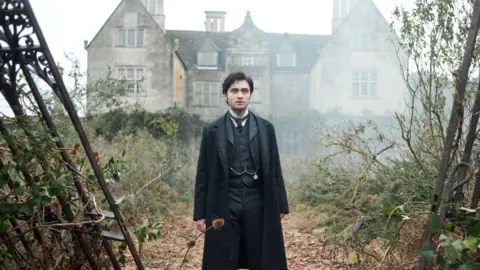 AJ Pics/Alamy
AJ Pics/AlamyIf you are lining up a few classic horror films this Halloween, you might recognise some familiar locations.
Forget the actors, directors and the crew – Historic England has been taking a look at some of the 400,000 listed sites in the country that have made it on to the big screen.
“Familiar places can be turned into something uncanny, unsettling,” says listing and architectural research director Charles O’Brien.
When it comes to horror films, he says England’s historic buildings and landscapes “provide an essential ingredient in making the audience’s flesh creep”.
Here are five of the frightening film settings handpicked for Historic England’s first Horror Histories list.
Cotterstock Hall, Northamptonshire
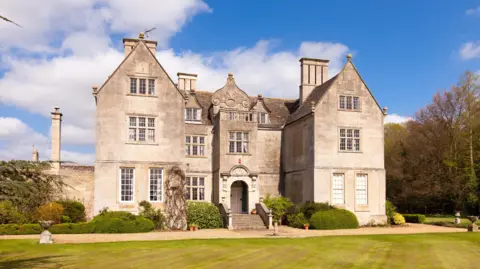 Haakon Dewing
Haakon DewingIn everyday life, Cotterstock Hall in Northamptonshire looks “very clean, neat and tidy”, says Mr O’Brien.
Not, however, in The Woman and Black.
The 2012 film adaptation of Susan Hill’s spooky novel stars Daniel Radcliffe as lawyer Arthur Kipps as he uncovers the terrifying secrets hidden in the Georgian building and grounds.
Mr O’Brien says the film team made the environment look broken down, heavily overgrown with weeds and undergrowth, and with “almost a sense of rottenness inherent in the fabric of the building”.
Cotterstock Hall is one of only 2.5% of listed buildings in England deemed to be of exceptional interest – or Grade I. Around 5.8% are Grade II*, meaning they are particularly important buildings of more than special interest. The rest are Grade II.
Listing gives buildings protection against certain changes. Anyone can recommend a building for listing.
Lindisfarne Castle, Northumberland
 Historic England Archive
Historic England ArchiveHorror comes to Northumberland’s Holy Island in Danny Boyle’s post-apocalyptic 28 Years Later (2025). The Grade I listed Lindisfarne Castle pops up in a pretty haunting landscape with its 16th Century fortress.
Laura Knowles works at Lindisfarne Castle as a visitor operations and experience manager for the National Trust, and was there during filming.
“We’ve definitely had some tourism off the back of it,” she says. “The village as a whole really came together and there was a great atmosphere.
She says many claim to have felt or seen something odd when visiting the castle, and there is talk of a ghostly white dog on the island.
“My only personal experience is when I’m locking the castle up on my own, maybe late at night, and the team have gone ahead of me,” she says.
“It can have a very spooky, creepy air to it at times. You’re aware that it’s just you in a very old, scary castle. It’s echoey and you get the wind howling through the chimneys and through the spaces – it can definitely feel eerie.”
Oakley Court, Berkshire
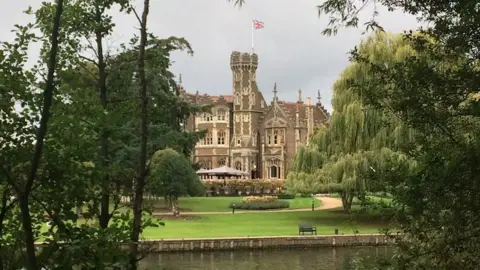 Dominic Martin/Missing Pieces Project
Dominic Martin/Missing Pieces ProjectHistoric England describes Berkshire’s Oakley Court as “the most recognisable horror film location in Britain”.
The gothic building with its octagonal tower was once home to Hammer Horror Studios.
It features in The Curse of Frankenstein, The Brides of Dracula, The Plague of the Zombies and cult classic, The Rocky Horror Picture Show.
The Headland, Cornwall
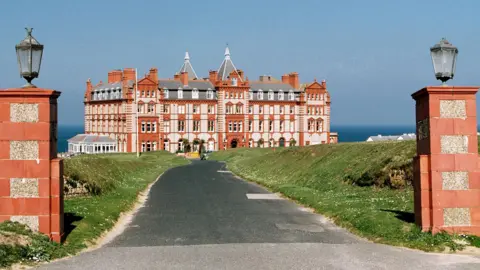 Historic England archive
Historic England archiveThey have purple eyes, they hate children and they roam around Hotel Excelsior.
The 1990 film adaptation of Roald Dahl’s The Witches may have terrified kids growing up, but the site is not quite as creepy in reality.
It was filmed at architect Silvanus Trevail’s The Headland hotel in Cornwall, a five star Grade II listed building.
“The Witches is about that discovery that actually these benign looking women turn out to be this coven of witches, so that is embodied in the hotel,” Mr O’Brien says.
“It is a resort, a place of play, but it does actually have its own sinister architectural character.”
Guildford Cathedral, Surrey
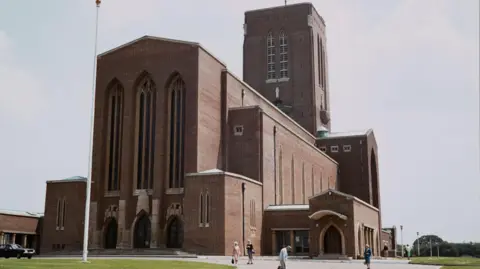 Historic England Archive
Historic England ArchiveGrade II* listed Guildford Cathedral features in the original 1976 film, The Omen.
When an American ambassador tells his wife a foundling is their newborn son, the film explores whether little Damien could be the Antichrist.
The cathedral appears in a scene showing Damien’s reluctance to enter churches.
The future of English film
With the use of AI it is now possible to make film locations and build worlds digitally, and meanwhile US President Donald Trump is threatening to impose a 100% tariff on all films not made in the US.
But Mr O’Brien is optimistic about the future of English film.
“AI and CGI can do all sorts of things, but one of the great bonuses of cinema is recognisable settings,” says Mr O’Brien. “Horror cinema in this country took a huge step forward when it got out of the studio.
“I hope whatever the ebb and flow of cinema in this country, people always think that’s something England really has to has to offer historically.
“People appreciate authenticity of place. I sincerely hope England’s heritage will be in film as long as there is film.”
Historic England’s Horror Histories list also includes:
- Heatherden Hall, Buckinghamshire, from The Amazing Mr Blunden (1972)
- Trafalgar Square, London, featured in An American Werewolf in London (1981)
- Church of St Mary Magdalene, Buckinghamshire, featured in Hammer House of Horror (1980)
- Church of St John the Evangelist, Kentwell Hall and Lavenham’s market place in Suffolk, all in Witchfinder General (1968)
This Halloween, Historic England is calling for people to contribute their memories of spooky historic places to the Missing Pieces Project, a register of all nationally protected historic buildings and sites in England.
It hopes that sharing photographs, videos and stories will help more people to discover some of the hundreds of thousands of listed locations across England.

